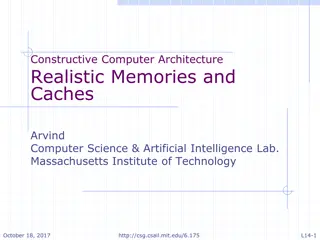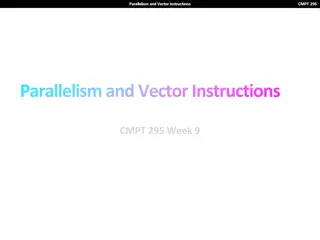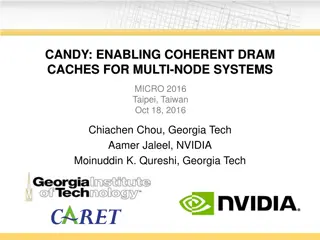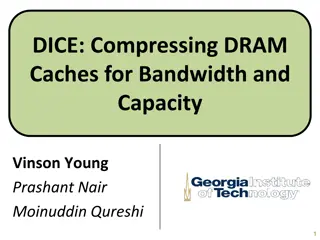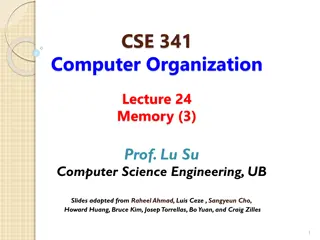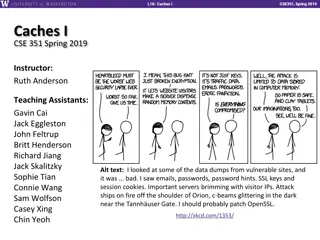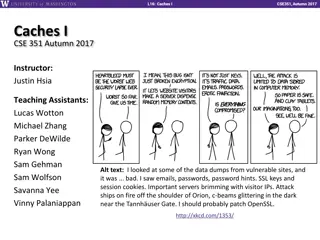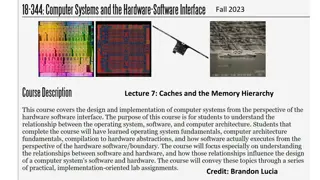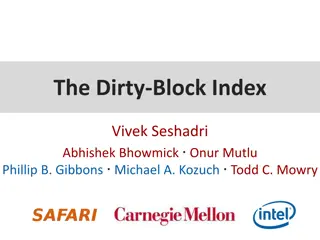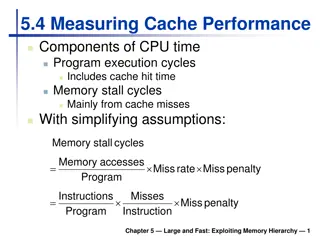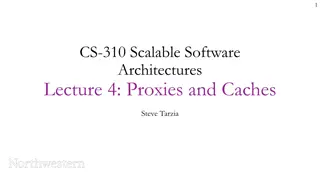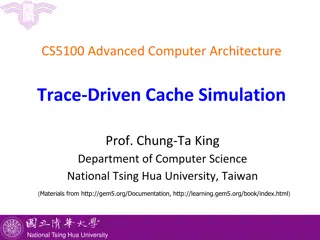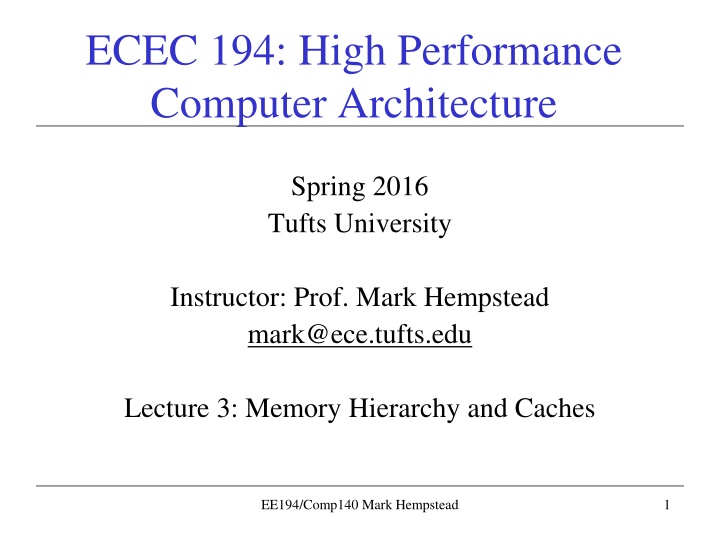
Memory Hierarchy and Caches Overview at Tufts University
Explore the concepts of memory hierarchy and caches in high-performance computer architecture, presented by Prof. Mark Hempstead at Tufts University. Understand the importance of memory management and performance optimization through a detailed examination of memory systems. Gain insights into addressing the CPU-DARM performance gap and the implementation of memory hierarchies to enhance computing efficiency.
Uploaded on | 1 Views
Download Presentation

Please find below an Image/Link to download the presentation.
The content on the website is provided AS IS for your information and personal use only. It may not be sold, licensed, or shared on other websites without obtaining consent from the author. If you encounter any issues during the download, it is possible that the publisher has removed the file from their server.
You are allowed to download the files provided on this website for personal or commercial use, subject to the condition that they are used lawfully. All files are the property of their respective owners.
The content on the website is provided AS IS for your information and personal use only. It may not be sold, licensed, or shared on other websites without obtaining consent from the author.
E N D
Presentation Transcript
ECEC 194: High Performance Computer Architecture Spring 2016 Tufts University Instructor: Prof. Mark Hempstead mark@ece.tufts.edu Lecture 3: Memory Hierarchy and Caches EE194/Comp140 Mark Hempstead 1
Outline Memory Hierarchy Cache review EE194/Comp140 Mark Hempstead 2
Histogram, done poorly I wrote a histogram program I did a really, really bad job. On purpose (mostly) 500M pieces of input data. int input_vals_per_thread = input_data.size() / n_threads; for (int i=0, idx=me; i<input_vals_per_thread; ++i) { ++my_hist[input_data[idx]]; idx += n_threads; } EE194/Comp140 Mark Hempstead 3
Histogram, done poorly 1 thread 1.3s 2 th 1.2s 4 th 1.7s 8 th 2s 16 th 32 th 4.9s 64 th 128 th 4.9 5s 4.9s int input_vals_per_thread = input_data.size() / n_threads; for (int i=0, idx=me; i<input_vals_per_thread; ++i) { ++my_hist[input_data[idx]]; idx += n_threads; } Explanations? We ll revisit this example at the end of our cache tutorial EE194/Comp140 Mark Hempstead 4
Memory Hierarchy Review Appendix B and Chapter 2 EE194/Comp140 Mark Hempstead 5
Since 1980, CPU has outpaced DRAM Q. How do architects address this gap? A. Put smaller, faster cache memories between CPU and DRAM. Create a memory hierarchy . Performance (1/latency) CPU 60% per yr 2X in 1.5 yrs CPU Gap grew 50% per year DRAM 9% per yr 2X in 10 yrs DRAM EE194/Comp140 Mark Hempstead 6 Year
Memory Hierarchy: Dell with Core i7 (Nehalem) Managed by compiler by hardware Managed by OS, hardware, application Managed L1 Inst 32K L1 Data 32K Disk (SSD) 120G 5*105 , 200u s Disk (HD) 1 TB 8.7*1 06, 3.2 ms Reg L2 L3 DRAM Size 1.25K 256K 8M 4G 107, 42.8 ns Latency Cycles, Time 1, 4, 3, 11, 39, 15.6 ns 0.4 ns 1.6 ns 1.6 ns 4.4 ns Goal: Illusion of large, fast, cheap memory Let programs address a memory space that scales to the disk size, at a speed that is usually as fast as register access EE194/Comp140 Mark Hempstead 7
Locality is the key The first time you reference a piece of data, you must fetch it from disk Even if you have fast caches Because at startup, the data isn t in those caches But the next time you reference that same data, you can grab it from your cache. Hopefully. But not always. This is called temporal locality (i.e., one location, referenced repeatedly over time) If an item is referenced, it will tend to be referenced again soon (e.g., loops, reuse) EE194/Comp140 Mark Hempstead 8
Spatial locality If an item is referenced, items whose addresses are close by tend to be referenced soon (e.g., straight-line code, array access) When you access a piece of data for the first time, the CPU actually loads an entire cache line of data into your cache (e.g., 64B) The next time you access any data in that line, it gets fetched from the cache, and hence accessed quickly EE194/Comp140 Mark Hempstead 9
The Principle of Locality Two Different Types of Locality: Temporal Locality (Locality in Time): If an item is referenced, it will tend to be referenced again soon (e.g., loops, reuse) Spatial Locality (Locality in Space): If an item is referenced, items whose addresses are close by tend to be referenced soon (e.g., straight-line code, array access) Locality is a property of nearly all programs that is exploited in machine design. Programs that don t actually have locality won t benefit from caches. Example: copy one column from one matrix to another (for row-major storage) EE194/Comp140 Mark Hempstead 10
Locality Example j=val1; k=val2; for (i=0; i<10000;i++) { A[i] += j; B[i] += k; } What temporal locality is here? What spatial locality? j, k, i A, B EE194/Comp140 Mark Hempstead 11
Locality applies to instructions j=val1; k=val2; for (i=0; i<10000;i++) { A[i] += j; B[i] += k; } For the instructions: What temporal locality is there? What spatial locality? all of them the inner loop EE194/Comp140 Mark Hempstead 12
Exploiting Locality: Memory Hierarchy CPU Hierarchy of memory components Upper components Fast Small Expensive Lower components Slow Big Cheap Connected by buses Which also have latency and bandwidth issues Most frequently accessed data in M1 M1 + next most frequently accessed in M2, etc. Move data up-down hierarchy Optimize average access time latencyavg = latencyhit + %miss*latencymiss Attack each component M1 M2 M3 M4 EE194/Comp140 Mark Hempstead 13
Concrete Memory Hierarchy Processor Compiler Managed Regs 0th level: Registers 1st level: Primary caches Split instruction (I$) and data (D$) Typically 8KB to 64KB each 2nd level: 2nd and 3rd cache (L2, L3) On-chip, typically made of SRAM 2nd level typically ~256KB to 512KB Last level cache typically 4MB to 16MB 3rd level: main memory Made of DRAM ( Dynamic RAM) Typically 1GB to 4GB for desktops/laptops Servers can have 100s of GB 4th level: disk (swap and files) Uses magnetic disks or flash drives 10s of GB or over 1 TB I$ D$ L2, L3 Hardware Managed Main Memory Software Managed (by OS) Disk EE194/Comp140 Mark Hempstead 14
Bigger caches = slower Each subsequent memory level is slower A bigger memory takes longer to access (just common sense, and in fact it's true) The wires to bigger caches tend to have less bandwidth than those to smaller caches They run longer distances, and so having wide busses is more expensive disk, memory, L3 L2 cache L1 cache regfile EE194/Comp140 Mark Hempstead 15
Evolution of Cache Hierarchies 64KB I$ 64KB D$ 8KB I/D$ 1.5MB L2 8MB L3 (shared) 256KB L2 (private) L3 tags Intel Core i7 (quad core) Intel 486 Chips today are 30 70% cache by area EE194/Comp140 Mark Hempstead 16
Cache tradeoffs Caches have LOTS of transistors; the potential for wasting power is correspondingly huge. Caches take up lots of area, which implies long wires, and thus unavoidable latencies. If we try to improve bandwidth by using wider buses or more pipelining, both will (as usual) cost power. More details to come. EE194/Comp140 Mark Hempstead 17
Where do misses come from? Classifying Misses: 3 Cs Compulsory First access to a block. Also called cold start misses or first reference misses. (Misses in even an Infinite Cache) Capacity If the cache cannot contain all the blocks needed during execution of a program, capacity misses will occur due to blocks being discarded and later retrieved. (Misses in Fully Associative Cache) Conflict If block-placement strategy is set associative or direct mapped, conflict misses (in addition to compulsory & capacity misses) will occur because a block can be discarded and later retrieved if too many blocks map to its set. Also called collision misses or interference misses. (Remaining Misses) 4th C : Coherence - Misses caused by cache coherence. EE194/Comp140 Mark Hempstead 18
3Cs Absolute Miss Rate (SPEC Benchmarks) 0.14 1-way Conflict 0.12 2-way Miss Rate per Type Miss rate 0.1 4-way 0.08 8-way 0.06 Capacity 0.04 0.02 0 1 2 4 8 16 32 64 128 Compulsory Cache Size (KB) EE194/Comp140 Mark Hempstead 19
Cache Organization? Assume total cache size not changed. Which of 3Cs is obviously affected (if any) if we Increased block size means fewer compulsory misses. It also means fewer blocks, which might increase conflict misses. And if it decreases spatial reuse, then it increases capacity misses. 1) Change Block Size: A compiler might do a better job of making accesses local, which would lessen compulsory and conflict misses. 2) Change Compiler: EE194/Comp140 Mark Hempstead 20
How far should we go? How many transistors should we spend on big caches? Caches cost power & area, and don't do any computing We already see pretty good hit rates If you organize your code very cleverly, you can often get it to run fast without needing a lot of cache But taking the time to organize your code cleverly takes time and time is money and most customers like to buy cheap software EE194/Comp140 Mark Hempstead 21
Histogram, done poorly 1 thread 1.3s 2 th 1.2s 4 th 1.7s 8 th 2s 16 th 32 th 4.9s 64 th 128 th 4.9 5s 4.9s int input_vals_per_thread = input_data.size() / n_threads; for (int i=0, idx=me; i<input_vals_per_thread; ++i) { ++my_hist[input_data[idx]]; idx += n_threads; } Let's look at how we access memory with different numbers of threads EE194/Comp140 Mark Hempstead 22
Memory patterns Look at one cache line. Who accesses each 4B chunk of the 64B line? 1 thread 0 0 0 0 0 0 0 0 0 0 0 0 0 0 0 0 2 threads 0 1 0 1 0 1 0 1 0 1 0 1 0 1 0 1 4 threads 0 1 2 3 0 1 2 3 0 1 2 3 0 1 2 3 8 threads 0 1 2 3 4 5 6 7 0 1 2 3 4 5 6 7 16 threads 0 1 2 3 4 5 6 7 8 9 10 11 12 13 14 15 EE194/Comp140 Mark Hempstead 23
How many cache lines? With just one thread, how many cache lines must that thread pull in? (500M elements) * (4B/element) * (1 line/64B) 32M lines With 2 threads, how many lines must each thread pull in? No different! What about 4, 8 or 16? Again, each thread must pull in every cache line! EE194/Comp140 Mark Hempstead 24
Histogram, done poorly 1 thread 1.3s 2 th 1.2s 4 th 1.7s 8 th 2s 16 th 32 th 4.9s 64 th 128 th 4.9 5s 4.9s int input_vals_per_thread = input_data.size() / n_threads; for (int i=0, idx=me; i<input_vals_per_thread; ++i) { ++my_hist[input_data[idx]]; idx += n_threads; } Any explanations for this behavior now? With so little work other than the loads and stores, memory accesses will almost certainly dominate the execution time. Every thread must still access every line So now we now why more threads (up to 16) don't make things faster. But why do more threads make execution slower? And why do things stop getting worse after 16 threads? EE194/Comp140 Mark Hempstead 25
More threads = slower Remember that there are multiple levels of cache Load data comes to the regfile from disk via all of the cache levels There are never enough wires to transfer data quickly between levels Bandwidth on those wires is likely our critical path How does this affect us? When we load entire cache lines and only use some of it, we're wasting bandwidth More threads any thread uses less of each cache line wastes more bandwidth runs slower. disk, memory, L3 L2 cache L1 cache regfile EE194/Comp140 Mark Hempstead 26
>16 threads = no more slowdown Look at one cache line. Who accesses each 4B chunk of the 64B line? 1 thread 0 0 0 0 0 0 0 0 0 0 0 0 0 0 0 0 2 threads 0 1 0 1 0 1 0 1 0 1 0 1 0 1 0 1 4 threads 0 1 2 3 0 1 2 3 0 1 2 3 0 1 2 3 8 threads 0 1 2 3 4 5 6 7 0 1 2 3 4 5 6 7 16 threads 0 1 2 3 4 5 6 7 8 9 10 11 12 13 14 15 EE194/Comp140 Mark Hempstead 27
>16 threads = no more slowdown With 16 threads, how many cache lines must each thread pull in? (500M elements) * (4B/element) * (1 line/64B) 32M lines With 32 threads, how many lines must each thread pull in? Now each thread's stride is big enough that it only touches half of the cache lines So each thread touches 16M lines With 64 threads, how many lines must each thread pull in? About 8M Thoughts on why things stop getting slower after 16 threads? Sure, that makes sense now. But why don't we suddenly get lots faster after 16 threads? Because just throwing more threads at a problem doesn't help if it's memory limited. EE194/Comp140 Mark Hempstead 28
Histogram, done poorly What went wrong? Our application does very little computation, and so is very dominated by memory access. In 2017, DRAM no longer can keep up with a CPU; we depend on caches Caches only works well when you have temporal or spatial locality (or both) Our histogram only used input data once no temporal locality We divvied up data between threads in a way that has less and less spatial locality the more threads we use EE194/Comp140 Mark Hempstead 29
What would you fix? int input_vals_per_thread = input_data.size() / n_threads; for (int i=0, idx=me; i<input_vals_per_thread; ++i) { ++my_hist[input_data[idx]]; idx += n_threads; } Any suggestions for how to change the code? EE194/Comp140 Mark Hempstead 30
What have we learned? If you have a program that has lots of memory accesses and little computation (i.e., runtime is dominated by memory access) doesn't cache well (little temporal or spatial locality) then more threads may make things slower rather than faster But now we're smarter than that, right? We'll divvy up work between threads to ensure each thread has spatial locality EE194/Comp140 Mark Hempstead 31
How many cache lines? Assume we divide the data between threads so as to have spatial locality. With just one thread, how many cache lines must that thread pull in? (500M elements) * (4B/element) * (1 line/64B) 32M lines With 2 threads, how many lines must each thread pull in? 16M each, so 32M total With N threads, how many lines must each thread pull in? 32M/N each, so 32M total EE194/Comp140 Mark Hempstead 32
More threads We still have lots of memory accesses and little computation Thoughts on what happens when we add more threads? More threads definitely adds more adders, more multipliers, and more computes. How much does that matter? But what does it do to memory-access rate? It's really hard to say. More on this shortly Not a lot EE194/Comp140 Mark Hempstead 33
Even simpler program for (int i=0; i<10; ++i) int sum=0; for (int j=0; j<N; ++j) sum = sum + vec[j]; Simple program: just sum up the elements of a vector The outer loop just repeats the entire thing 10 times, to minimize cold-cache effects Like the histogram, it's dominated by memory access. How does the time to run this code change as you increase N? How does time/N change as you increase N? EE194/Comp140 Mark Hempstead 34
Even simpler program for (int i=0; i<10; ++i) int sum=0; for (int j=0; j<N; ++j) sum = sum + vec[j]; How does the time to run this code change as you increase N? How does time/N change as you increase N? time/N N EE194/Comp140 Mark Hempstead 35
Walk through Assume N=64, and L1 cache has 4 lines of 64B. Assume each box below is 4B (one integer) Let's look at the cache as we walk through the code execution L1 line 0 L1 line 1 L1 line 2 L1 line 3 EE194/Comp140 Mark Hempstead 36
Walk through for (int i=0; i<10; ++i) int sum=0; for (int j=0; j<N; ++j) sum = sum + vec[j]; Here is a snapshot of the L1 cache when i=0, after j=0 code is done Why is the entire line #0 loaded, and not just 4B? Because caches work in entire lines [15] [14] [13][12] [11] [10] [9] [8] [7] [6] [5] [4] [3] [2] [1] [0] L1 line 0 L1 line 1 L1 line 2 L1 line 3 EE194/Comp140 Mark Hempstead 37
Walk through for (int i=0; i<10; ++i) int sum=0; for (int j=0; j<N; ++j) sum = sum + vec[j]; Here is a snapshot of the L1 cache when i=0, after j=15 code is done The L1 cache is still the same; j=1 through j=15 all hit in the L1 cache. [15] [14] [13][12] [11] [10] [9] [8] [7] [6] [5] [4] [3] [2] [1] [0] L1 line 0 L1 line 1 L1 line 2 L1 line 3 EE194/Comp140 Mark Hempstead 38
Walk through for (int i=0; i<10; ++i) int sum=0; for (int j=0; j<N; ++j) sum = sum + vec[j]; Here is a snapshot of the L1 cache when i=0, after j=16 code is done As before, the entire line #1 is loaded [15] [14] [13][12] [11] [10] [9] [8] [7] [6] [5] [4] [3] [2] [1] [0] L1 line 0 L1 line 1 L1 line 2 L1 line 3 [31] [30] [29][28] [27] [26] [25][24] [23] [22] [21][20] [19] [18] [17][16] EE194/Comp140 Mark Hempstead 39
Walk through for (int i=0; i<10; ++i) int sum=0; for (int j=0; j<N; ++j) sum = sum + vec[j]; Here is a snapshot of the L1 cache when i=0, after j=32 code is done [15] [14] [13][12] [11] [10] [9] [8] [7] [6] [5] [4] [3] [2] [1] [0] L1 line 0 L1 line 1 L1 line 2 L1 line 3 [31] [30] [29][28] [27] [26] [25][24] [23] [22] [21][20] [19] [18] [17][16] [47] [46] [45][44] [43] [42] [41][40] [39] [38] [37][36] [35] [34] [33][32] EE194/Comp140 Mark Hempstead 40
Walk through for (int i=0; i<10; ++i) int sum=0; for (int j=0; j<N; ++j) sum = sum + vec[j]; Here is a snapshot of the L1 cache when i=0, after j=63 code is done Now the L1 cache has reached capacity (i.e., it's full) Fortunately, our inner loop is finished (since N=64) L1 line 0 L1 line 1 L1 line 2 L1 line 3 [62] [63] [61][60] [58] [59] [15] [14] [13][12] [11] [10] [9] [8] [7] [6] [5] [4] [3] [2] [1] [0] [31] [30] [29][28] [27] [26] [25][24] [23] [22] [21][20] [19] [18] [17][16] [47] [46] [45][44] [43] [42] [41][40] [39] [38] [37][36] [35] [34] [33][32] [57][56] [55] [54] [53][52] [51] [50] [49][48] EE194/Comp140 Mark Hempstead 41
Walk through for (int i=0; i<10; ++i) int sum=0; for (int j=0; j<N; ++j) sum = sum + vec[j]; Next up: i=1, and i=2, etc. Predictions: will these loops run faster? Yes: everything will now hit in the L1 cache [15] [14] [13][12] [11] [10] [9] [8] [7] [6] [5] [4] [3] [2] [1] [0] L1 line 0 L1 line 1 L1 line 2 L1 line 3 [31] [30] [29][28] [27] [26] [25][24] [23] [22] [21][20] [19] [18] [17][16] [47] [46] [45][44] [43] [42] [41][40] [39] [38] [37][36] [35] [34] [33][32] [63] [62] [61][60] [59] [58] [57][56] [55] [54] [53][52] [51] [50] [49][48] EE194/Comp140 Mark Hempstead 42
Walk through for (int i=0; i<10; ++i) int sum=0; for (int j=0; j<N; ++j) sum = sum + vec[j]; So with N=64, the first loop (i=0) is slow And the rest are fast What if N=65? Predictions? Everything will still hit in the L1? Nothing? 64 out of 65 accesses will hit? 48 out of 65? [15] [14] [13][12] [11] [10] [9] [8] [7] [6] [5] [4] [3] [2] [1] [0] L1 line 0 L1 line 1 L1 line 2 L1 line 3 [31] [30] [29][28] [27] [26] [25][24] [23] [22] [21][20] [19] [18] [17][16] [47] [46] [45][44] [43] [42] [41][40] [39] [38] [37][36] [35] [34] [33][32] [63] [62] [61][60] [59] [58] [57][56] [55] [54] [53][52] [51] [50] [49][48] EE194/Comp140 Mark Hempstead 43
Walk through for (int i=0; i<10; ++i) int sum=0; for (int j=0; j<N; ++j) sum = sum + vec[j]; At the end of i=0, j=63, we're at the same place as before The L1 cache is full, with vec[63:0] [15] [14] [13][12] [11] [10] [9] [8] [7] [6] [5] [4] [3] [2] [1] [0] L1 line 0 L1 line 1 L1 line 2 L1 line 3 [31] [30] [29][28] [27] [26] [25][24] [23] [22] [21][20] [19] [18] [17][16] [47] [46] [45][44] [43] [42] [41][40] [39] [38] [37][36] [35] [34] [33][32] [63] [62] [61][60] [59] [58] [57][56] [55] [54] [53][52] [51] [50] [49][48] EE194/Comp140 Mark Hempstead 44
Walk through for (int i=0; i<10; ++i) int sum=0; for (int j=0; j<N; ++j) sum = sum + vec[j]; What happens with we execute the j=64 code? We want to pull in another line (vec[79:64], but there's no place to put it!) [15] [14] [13][12] [11] [10] [9] [8] [7] [6] [5] [4] [3] [2] [1] [0] L1 line 0 L1 line 1 L1 line 2 L1 line 3 [31] [30] [29][28] [27] [26] [25][24] [23] [22] [21][20] [19] [18] [17][16] [47] [46] [45][44] [43] [42] [41][40] [39] [38] [37][36] [35] [34] [33][32] [63] [62] [61][60] [59] [58] [57][56] [55] [54] [53][52] [51] [50] [49][48] EE194/Comp140 Mark Hempstead 45
Walk through for (int i=0; i<10; ++i) int sum=0; for (int j=0; j<N; ++j) sum = sum + vec[j]; Evict one line but which one? Choose the one who has been in the cache longest [15] [14] [13][12] [11] [10] [9] [8] [7] [6] [5] [4] [3] [2] [1] [0] L1 line 0 L1 line 1 L1 line 2 L1 line 3 [31] [30] [29][28] [27] [26] [25][24] [23] [22] [21][20] [19] [18] [17][16] [47] [46] [45][44] [43] [42] [41][40] [39] [38] [37][36] [35] [34] [33][32] [63] [62] [61][60] [59] [58] [57][56] [55] [54] [53][52] [51] [50] [49][48] EE194/Comp140 Mark Hempstead 46
Walk through for (int i=0; i<10; ++i) int sum=0; for (int j=0; j<N; ++j) sum = sum + vec[j]; When i=0, after j=64 code is done [79] [78] [77][76] [75] [74] [73][72] [71] [70] [69][68] [67] [66] [65][64] L1 line 0 L1 line 1 L1 line 2 L1 line 3 [31] [30] [29][28] [27] [26] [25][24] [23] [22] [21][20] [19] [18] [17][16] [47] [46] [45][44] [43] [42] [41][40] [39] [38] [37][36] [35] [34] [33][32] [63] [62] [61][60] [59] [58] [57][56] [55] [54] [53][52] [51] [50] [49][48] EE194/Comp140 Mark Hempstead 47
Walk through for (int i=0; i<10; ++i) int sum=0; for (int j=0; j<N; ++j) sum = sum + vec[j]; OK, we've reached the end of our loop, and summed the entire array. Now it's on to i=1 [79] [78] [77][76] [75] [74] [73][72] [71] [70] [69][68] [67] [66] [65][64] L1 line 0 L1 line 1 L1 line 2 L1 line 3 [31] [30] [29][28] [27] [26] [25][24] [23] [22] [21][20] [19] [18] [17][16] [47] [46] [45][44] [43] [42] [41][40] [39] [38] [37][36] [35] [34] [33][32] [63] [62] [61][60] [59] [58] [57][56] [55] [54] [53][52] [51] [50] [49][48] EE194/Comp140 Mark Hempstead 48
Walk through for (int i=0; i<10; ++i) int sum=0; for (int j=0; j<N; ++j) sum = sum + vec[j]; Any predictions for how many cache hits we'll get? None! All it takes is increasing N by 1 to go from everything hits in the L1 to nothing hits! [79] [78] [77][76] [75] [74] [73][72] [71] [70] [69][68] [67] [66] [65][64] L1 line 0 L1 line 1 L1 line 2 L1 line 3 [31] [30] [29][28] [27] [26] [25][24] [23] [22] [21][20] [19] [18] [17][16] [47] [46] [45][44] [43] [42] [41][40] [39] [38] [37][36] [35] [34] [33][32] [63] [62] [61][60] [59] [58] [57][56] [55] [54] [53][52] [51] [50] [49][48] EE194/Comp140 Mark Hempstead 49
Even simpler program for (int i=0; i<10; ++i) int sum=0; for (int j=0; j<N; ++j) sum = sum + vec[j]; How does the time to run this code change as you increase N? How does time/N change as you increase N? time/N N EE194/Comp140 Mark Hempstead 50



